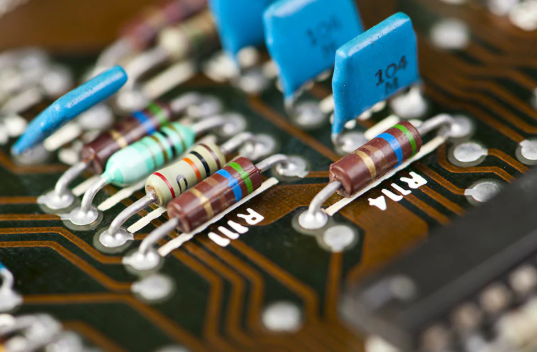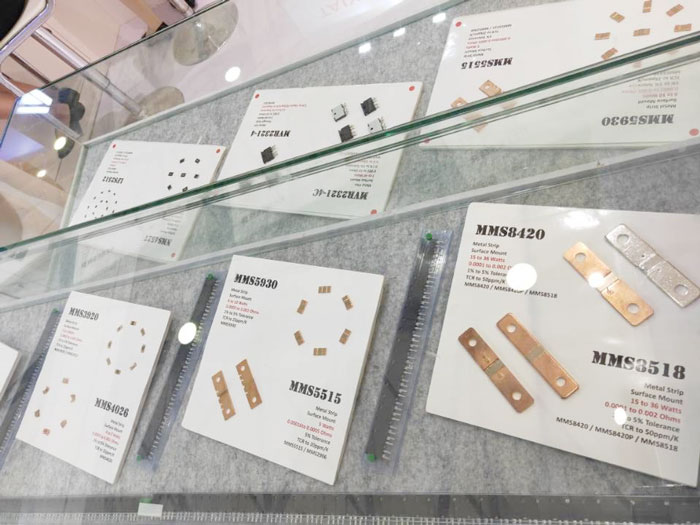Position:Home » Industry News
Circuit Design with Resistors in Series
Writer:Microhm Page View:Date:2019-12-30
The basics of electronics involve calculating the equivalent resistors in series or parallel. The designer learns the resistance of resistors in series is the sum of all the resistances, and when mounted in parallel, the inverse of the final resistor is equal to the sum of the inverse of the resistors. Micrhom Electronics provides broad range of resistors for engineers' options.
In the second step, designers learn that two resistors in series create a voltage divider. If one of these resistors is an NTC (Negative Temperature Coefficient resistor) or PTC (Positive Temperature Coefficient resistor), its resistance changes linearly versus the temperature. The output of the voltage divider can be connected to an ADC, and a digital thermometer is designed. In some designs, inexperienced designers may put resistors in series apparently without reason, as there is no connection between the resistors.

However, 3 major reasons can force a designer to design resistors in series:
- The required resistance does not exist and a combination of several standard resistances is required to obtain the resistance desired.
- The resistor cannot work under the maximum required voltage. In this case, the resistors are placed in series, as each one will see a lower voltage than the maximum required voltage of the application. But care must be taken if unequal values are picked up in order to guarantee none will undergo a voltage above its own rating.
- If the board is under a tough environment and a resistor is at risk of short circuiting, putting several resistors in series can mitigate the risk.
Similarly, some designs can require putting resistors in parallel. This is often the case in an H-bridge configuration where shunt resistors are placed at the bottom of the bridge to monitor the current. This practice is used in motor control and power applications where currents are several amperes and shunt resistors, like MPR series, MVR series and MMS series from Microhm Electronics can be utilized. In this case, resistors are put in parallel for the following reasons:

- To be able to dissipate the power. As the power to dissipate is proportional to the square of the current, even with low resistances the power can be much higher than what a single resistor can withstand. Several resistors in parallel can share this burden.
- When used in an H-bridge configuration, the voltage across the shunt resistor must stay relatively low versus the application voltage. By having the resistors in parallel, very low resistance is achievable, and even a very high current will create a small voltage that is negligible for the application but high enough to monitor the current.
To conclude, when resistors are designed, all component specifications must be checked to ensure they are not used outside a safe range. If there is a risk for components to be outside safe boundaries, it is necessary to create an equivalent resistance by designing resistors in series or in parallel. Come and find appropriate resistors in Microhm Electronics, there will be more suprise waiting for you.
In the second step, designers learn that two resistors in series create a voltage divider. If one of these resistors is an NTC (Negative Temperature Coefficient resistor) or PTC (Positive Temperature Coefficient resistor), its resistance changes linearly versus the temperature. The output of the voltage divider can be connected to an ADC, and a digital thermometer is designed. In some designs, inexperienced designers may put resistors in series apparently without reason, as there is no connection between the resistors.

However, 3 major reasons can force a designer to design resistors in series:
- The required resistance does not exist and a combination of several standard resistances is required to obtain the resistance desired.
- The resistor cannot work under the maximum required voltage. In this case, the resistors are placed in series, as each one will see a lower voltage than the maximum required voltage of the application. But care must be taken if unequal values are picked up in order to guarantee none will undergo a voltage above its own rating.
- If the board is under a tough environment and a resistor is at risk of short circuiting, putting several resistors in series can mitigate the risk.
Similarly, some designs can require putting resistors in parallel. This is often the case in an H-bridge configuration where shunt resistors are placed at the bottom of the bridge to monitor the current. This practice is used in motor control and power applications where currents are several amperes and shunt resistors, like MPR series, MVR series and MMS series from Microhm Electronics can be utilized. In this case, resistors are put in parallel for the following reasons:

- To be able to dissipate the power. As the power to dissipate is proportional to the square of the current, even with low resistances the power can be much higher than what a single resistor can withstand. Several resistors in parallel can share this burden.
- When used in an H-bridge configuration, the voltage across the shunt resistor must stay relatively low versus the application voltage. By having the resistors in parallel, very low resistance is achievable, and even a very high current will create a small voltage that is negligible for the application but high enough to monitor the current.
To conclude, when resistors are designed, all component specifications must be checked to ensure they are not used outside a safe range. If there is a risk for components to be outside safe boundaries, it is necessary to create an equivalent resistance by designing resistors in series or in parallel. Come and find appropriate resistors in Microhm Electronics, there will be more suprise waiting for you.
Latest News
- Resistor's role in measuring and correcting LED,,,
- Single through-hole resistors' characteristics ,,,
- Why shunt resistors for current sense applicati,,,
- Metal-film resistors with small size, high resi,,,
- 36W High-Current Shunt Resistors MMS8420,,,
- 1W Surface Mount Resistor MPR1206,,,
- An Overview of Microhm Electronics' Resistor Pr,,,
- More anti-sulfur resistors used in harsh envir,,,
- Resistance changes with temperature,,,
- 140W TO247 High Power Heatsinkable Resistor,,,
- MMS5930 is ideal for current sensing in industr,,,
- Shunt resistors selection for engineers' design,,,
- Considerations for choosing precision resistors,,,
- Ceramic Encased Cement Resistors NWH Series for,,,
- Resistors for Passive Balancing in Battery-Pow,,,
Hot Articles
- Microhm will take part in 10th Automotive World,,,
- Thanks for Visiting Microhm's Booth E5-5706 in ,,,
- Resistors in Short Supply: Blame Cars,,,
- New lunch: High Power Precision Shunt Resistor,,,,
- How to Test a Resistor,,,
- Innovative Technology, Future Electric: Electri,,,
- What is Precision Resistors?,,,
- SMD Resistors Sizes and Packages,,,
- The Construction and Features of Metal Film Res,,,
- What is a TO-220 Resisor?,,,
- Hot Selling Products: Precision Shunt Resistors,,,
- How to Calculate the Equivalent Resistance Valu,,,
- What is a Fixed Resistor?,,,
- Resistors in LED Circuits,,,
- Resistors Types and Materials Overview,,,
Resistance applications
- Heater Blower Motor Resistor in Air Conditioner,,,
- Difference Between High Precision Resistors and,,,
- The Four Important Functions of Alloy Resistors,,,
- The Measurement Accuracy of Automotive Shunt is,,,
- BMS for New Energy Vehicle,,,
- Shunt Resistor MMS8420 for High Current Stable ,,,
- Miniature future for passive electronic compone,,,
- Urbanization Development Bringing the Transform,,,
- Carbon Film Resistors' Features and Application,,,
- The Main Application for High Precision and Low,,,
- Industrial Roberts Applied to Solar Photovoltai,,,
- Why Zero-Ohm Resistors?,,,
- Precision Resistors' Construction and TCR,,,
- Surface Mount Resistor's Size and Package ,,,
- Select the Right Resistor for Harmonic Filterin,,,
